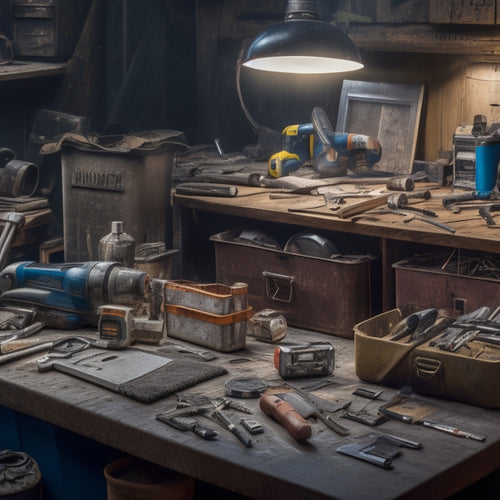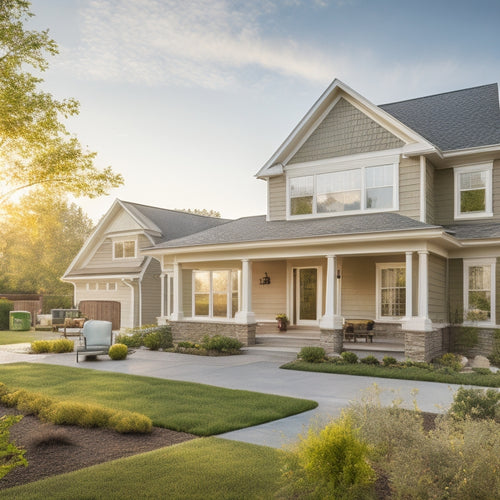
3 Best Tools for Exterior Block Wall Renovation
Share
When renovating an exterior block wall, you'll need a strategic combination of tools to achieve a durable, visually appealing result. For demolition, a hydraulic breaker or wrecking bar will effectively break down the existing structure. Next, a wire brush and pressure washer will prepare the surface for new applications. Finally, a texture gun or high-quality roller will help you achieve the desired finish. By mastering these essential tools, you'll be well on your way to a successful renovation - and uncovering the finer details of the process can lead to even more impressive results.
Key Takeaways
• For exterior block wall renovation, use a wire brush to remove dirt, grime, and old mortar for strong bonding.
• A pressure washer is essential for cleaning surfaces without damaging block and effectively removing dirt.
• A scraper or putty knife eliminates old mortar and adhesive, ensuring a smooth finish for new textures.
• Dust management is crucial, using vacuum or dustless sanding systems to keep the workspace clean and minimize airborne debris.
• For a uniform finish, use high-quality painting tools, such as rollers, extension poles, brushes, and paint sprayers, and employ techniques like 'W' or 'M' painting patterns.
Essential Demolition Equipment Needed
When tackling an exterior block wall renovation, you'll need to demolish the existing structure, which requires a range of essential demolition equipment to guarantee a safe and efficient process.
Demolition safety is vital, and the right equipment selection can make all the difference. Start by investing in personal protective gear, including hard hats, safety glasses, and gloves.
Next, focus on the heavy-hitters: hydraulic breakers, jackhammers, and wrecking bars. These tools will help you dismantle the block wall quickly and effectively.
Don't forget about dust suppression tools, like misting systems or dustless sanding vacuums, to minimize airborne debris. A reliable demolition hammer and chisels will also come in handy for more precise work.
When selecting equipment, consider factors like power source, weight, and ergonomics to guarantee you can work efficiently without compromising safety.
Surface Preparation Tool Essentials
You'll need a set of specialized tools to prepare the surface of your exterior block wall for renovation, starting with a wire brush to remove dirt, grime, and old mortar. This step is vital in ensuring a strong bond between the old surface and new materials.
A pressure washer is essential for surface cleaning techniques, allowing you to blast away stubborn dirt and grime without damaging the block.
A scraper or putty knife will help remove old mortar and adhesive residue, leaving a smooth surface for renovation.
A sanding block or orbital sander will help smooth out the surface, preparing it for new wall texture options such as stucco, paint, or veneer.
A vacuum or dustless sanding system will contain and remove debris, keeping your workspace clean and safe.
Finishing Touches Application Tools
With the surface prepared, you're ready to apply finishing touches, and a range of specialized tools will help you achieve a professional-looking result.
For painting, you'll need high-quality rollers, extension poles, and brushes specifically designed for exterior block walls. Consider investing in a paint sprayer for uniform coverage and to reach hard-to-access areas. Don't forget to choose the right painting techniques, such as using a 'W' or 'M' pattern, to minimize streaks and guarantee an even finish.
When it comes to texture options, you'll need a texture gun or a stomp brush to achieve the desired effect. A hopper gun is ideal for applying thick, heavy textures, while a stomp brush is better suited for creating subtle, knockdown textures.
For a more rustic look, consider using a texture rake or a trowel to create a unique, hand-applied finish. With the right tools and techniques, you'll be able to achieve a stunning, long-lasting finish that enhances the exterior of your block wall.
Frequently Asked Questions
Can I Renovate an Exterior Block Wall Without Professional Help?
You're wondering if you can tackle an exterior block wall renovation on your own. While it's possible, consider the DIY tips:
Assess your skills, prepare for physical labor, and research local building codes.
Cost considerations are also essential, as materials and potential mistakes can add up quickly.
If you're not confident in your abilities, hiring a pro might be the better investment.
How Do I Ensure Structural Integrity During the Renovation Process?
When renovating an exterior block wall, you'll want to debunk the theory that structural integrity is solely dependent on the wall's aesthetic appeal.
In reality, it's essential to prioritize load bearing considerations and foundation assessment.
You'll need to identify the wall's load-bearing points and verify the foundation's stability to guarantee it can support the weight of the renovated wall.
Don't assume the existing structure can handle the changes – verify it through thorough assessment and testing.
What Safety Gear Is Necessary for Exterior Block Wall Renovation?
When tackling an exterior block wall renovation, you'll need to prioritize your safety above all else.
You'll require essential safety gear, including a hard hat, safety glasses, and a dust mask to protect yourself from falling debris and airborne particles.
Don't forget steel-toed boots, gloves, and a harness if you'll be working at heights.
Invest in high-quality, durable protective equipment to guarantee your well-being throughout the renovation process.
Can I Reuse Existing Block or Do I Need New Materials?
You're at a crossroads, deciding whether to 'bite the bullet' and reuse existing blocks or start from scratch.
To make an informed decision, you'll need to conduct a thorough block condition assessment.
Evaluate the blocks' structural integrity, looking for signs of damage, erosion, or deterioration.
Next, perform a material compatibility evaluation to guarantee new mortar and materials will bond seamlessly with the existing blocks.
If they pass the test, reuse might be a viable option; if not, new materials are the way to go.
How Do I Handle Unexpected Issues That Arise During Renovation?
When unexpected issues arise during renovation, you'll need to employ effective problem-solving strategies to stay on track.
First, acknowledge the issue and assess its impact on your project timeline and budget.
Then, prioritize potential solutions, considering factors like cost, feasibility, and long-term implications.
Implement a contingency plan, and adjust your project management approach as needed.
Conclusion
As you stand back to admire your newly renovated exterior block wall, the transformation is like a phoenix rising from the ashes.
The once-drab surface now shines like a polished gem, thanks to the right tools.
Your demolition hammer shattered the old, making way for the new.
Your surface prep tools smoothed the rough edges, and your finishing touches application tools brought it all together.
The result is a masterpiece, a demonstration of your hard work and the power of the right tools.
Related Posts
-

Smart Guide to Buying Second-Hand Renovation Tools
When buying second-hand renovation tools, you'll want to set clear renovation goals and a realistic budget to priorit...
-

7 Best Home Renovation Project Checklists With Timelines
You're about to initiate a home renovation project, and establishing a clear plan with timelines is vital to staying ...
-

Streamline Your Exterior Renovation Timeline
To streamline your exterior renovation timeline, you'll need to approach the process strategically. Start by planning...


